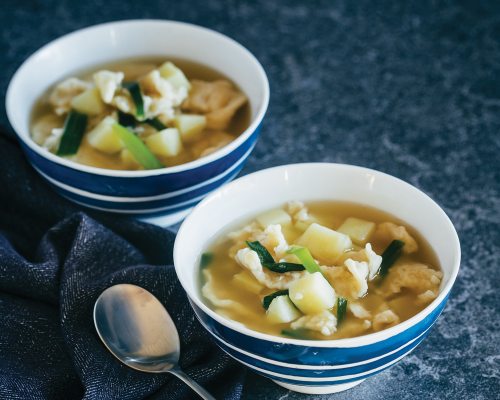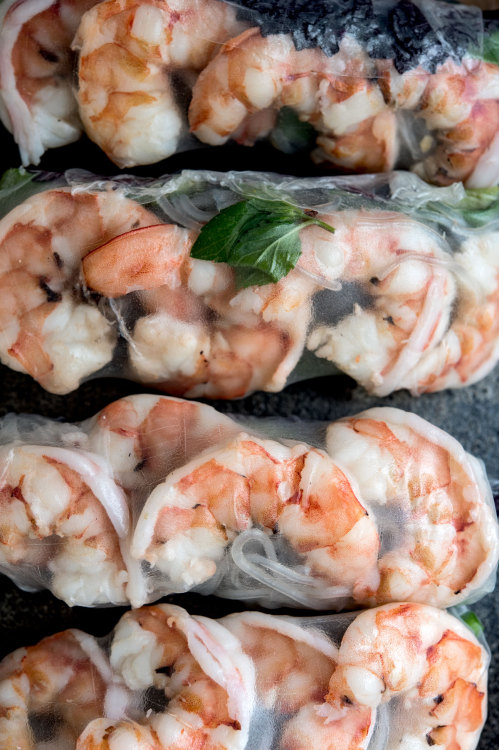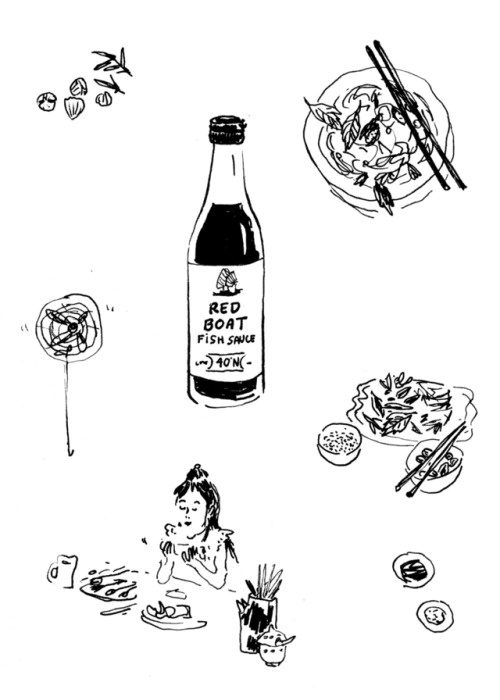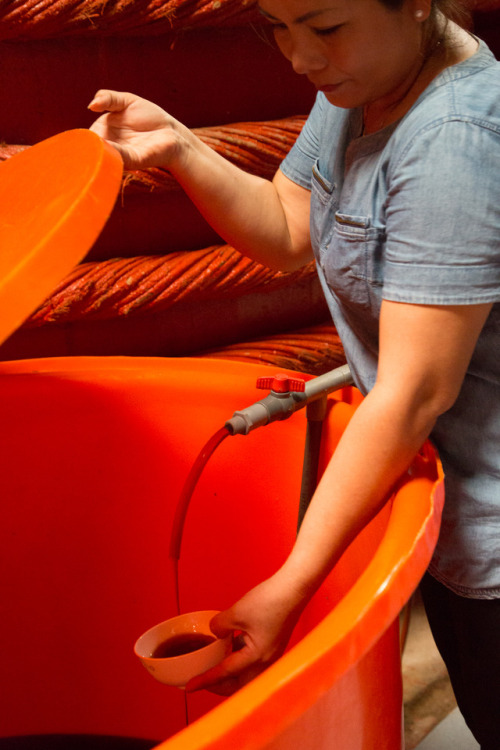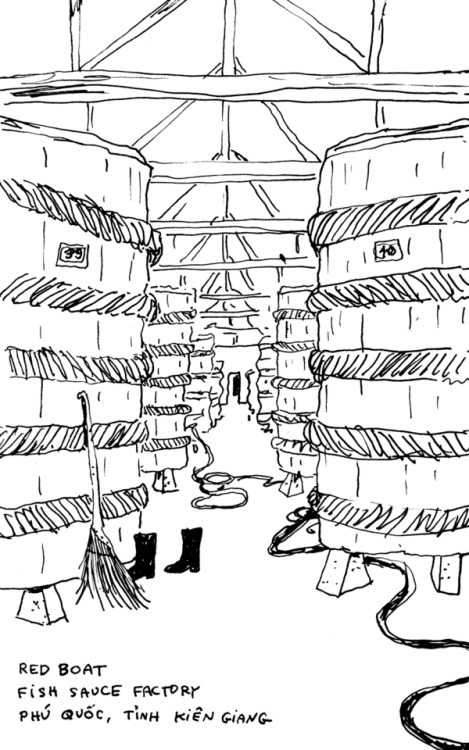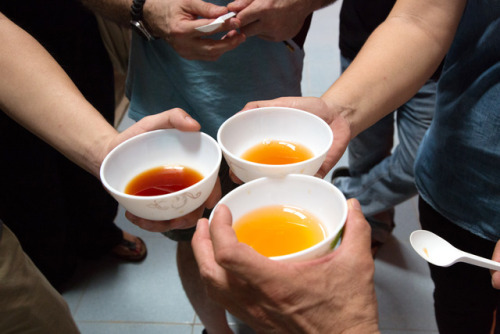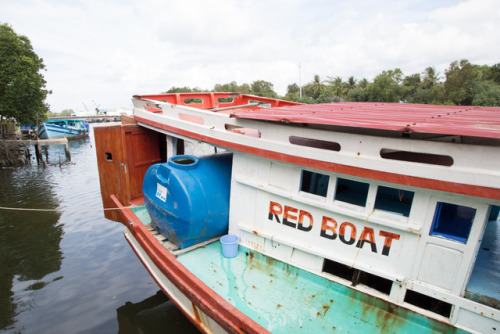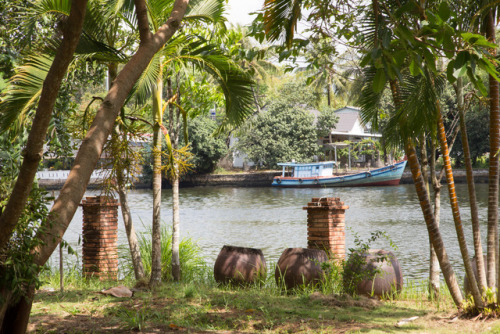#fish sauce
Thai Red Curry Seafood Soup
Recipe cooked, styled, and developed by Angela Magdangal.
Photo by Gia Garganese.
Dynasty by Teez Agency
Post link
Vietnamese Braised Pork Ribs
Servings: 4
Time: 2 hr + marinating
STUFF
2 medium shallots, finely chopped
2 lemongrass stalks, tough outer layer removed, lightly smashed and very finely chopped (about 2 tablespoons)
2 tablespoons soy sauce
1 tablespoon fish sauce (such as Red Boat)
1 tablespoon hot chile paste (such as sambal oelek)
2 teaspoons kosher salt
2 tablespoons brown sugar
2 teaspoons Chinese five-spice powder
1 tablespoon grated garlic
2 tablespoons finely chopped or grated ginger
3 to 4 pounds baby back ribs
4 scallions, slivered or chopped, for garnish
Cilantro and mint sprigs, for garnish
STEPS
Make the marinade: In a small bowl, put the shallots, lemongrass, soy sauce, fish sauce, chile paste, salt, sugar, five-spice powder, garlic and ginger. Mix well.
Put the meat in a deep baking dish or roasting pan and add marinade. Using your hands, coat ribs well. Let marinate, refrigerated, for at least 2 hours and preferably overnight, well wrapped. Bring back to room temperature before proceeding.
Heat oven to 450 degrees. Add 2 cups water to the pan, cover tightly with foil and place pan in oven. Cook for 30 minutes, then reduce heat to 350 degrees for 1 hour more. When done, the meat should be very tender, nearly but not quite falling off the bone. Remove cover and return to the oven for about 15 minutes until the ribs are nicely browned.
Remove ribs from pan. Pour pan juices into a saucepan and skim fat. Reduce over high heat until somewhat thickened, about 5 minutes. Meanwhile, divide ribs with a sharp knife and pile them onto a platter.
Serve family style with steamed rice and pan juices. Garnish with scallions, cilantro and mint sprigs.
NUTRITION
952 calories
65 grams fat
23 grams saturated fat
0 grams trans fat
27 grams monounsaturated fat
10 grams polyunsaturated fat
14 grams carbohydrates
1 gram dietary fiber
7 grams sugars
77 grams protein
273 mg cholesterol
1145 mg sodium
Post link
Slow Cooker Thai Green Chicken Curry
Servings: 6
Prep Time: 15 min
Cook Time: 3-4 hours on high, 6-8 hrs on low
STUFF
1 lb chicken thighs
1 medium sweet onion, finely diced
2 tablespoons Thai Green Curry Paste*
1 tablespoon crushed garlic
1 tablespoon minced Ginger
1 tablespoon lemongrass paste or fresh chopped lemongrass
1 Red chilli - finely diced
1 tablespoon fish sauce
1 tablespoon Raw honey
¾ cup coconut milk
¾ cup chicken stock/broth
4 fresh Kaffir Lime Leaves
½ teaspoon salt
1 cup red potatoes, quartered
2 cups baby spinach
2 cups Jasmine rice, optional, for serving
STEPS
In a large non-stick pan set to high, brown the meat for 2 to 3 minutes. Add the onion, garlic, ginger and chili and lemongrass stir through for 2 to 3 minutes until fragrant.
Add the meat to the slow cooker, and add the curry paste, fish sauce, honey, lime leaves, stock/broth, and potatoes. Stir to combine.
Set slow cooker to cook on low for 7 hours, or cook on high for 3 hours. Add the coconut milk, stir and cook for 1 more hour.
Once its finished cooking stir in the baby spinach and serve, with steamed jasmine rice if you like.
NOTES
Curry Paste: 2 tablespoons Thai Green Curry Paste will result in a mild curry. For a medium curry, increase to 3 tablespoons of curry paste.
Kaffir Lime leaves are available from supermarkets in the fresh fruit and veg section. There are also bottled kaffir lime leaves in the Asian section of Woolworths and Coles that you could try if you can’t find the fresh ones.
This recipe is suitable to freeze for up to 8 weeks.
To make this recipe on the stovetop, cook in a large saucepan with the lid on low heat for 3 hours, checking every hour. If cooking on the stovetop, you will need more liquid. Generally about ½ to 1 cup extra of either water or coconut milk should do the trick. However, do keep an eye on it to ensure it doesn’t dry out and burn.
Post link
Fish Sauce: The Heart of Vietnamese Cuisine
Location: Phu Quoc, Vietnam
If you love Southeast Asian food, you most likely know the wonders of fish sauce. It’s the umami-packed, savory heart of most dressings and sauces in that part of the world. Whether it is immediately detectable to the consumer or not, it’s the secret ingredient that defines the best Vietnamese dishes. When we found out that the location where most fish sauce is made is a tropical island with stunning beaches and bountiful open-air markets, it suddenly became critical that we go to the source. In preparation for a round of Vietnamese destination specials, Chopt’s chef Aneesha Hargrave, illustrator extraordinaire Joana Avillez and I flew 20-plus hours to the island of Phu Quoc to visit our friends at Red Boat fish sauce and get a handle on their stinky, delicious production.
Google the island of Phu Quoc and the image results define your notion of paradise: white sand, bright blue water, palm trees—the whole kit and kaboodle. The island is so far south and remote, the tourist industry is only just beginning to burgeon, with resorts dotted along the coastline, some with beach shacks, and others taking design inspiration from Disneyland. Fishing has always been the leading industry here, specifically black anchovies used to make fish sauce and it’s Chopt’s source for fish sauce in all our restaurants.
Turquoise and red wooden boats sail four hours out into the sea by moonlight, finally anchoring in the wee hours of the morning. They release a net into the water and haul tons (literally) of anchovies onto the deck of the boat. Chef Aneesha went along for the grueling, all-night adventure, without so much as a place to rest or sit on board. She captured swarms of metallic, glimmering fish dramatically lit by floodlights in the pitch black night and experienced the rush to toss them with sea salt and preserve their peak freshness on the long trip back to shore.
Once at the factory, we got the play-by-play from Red Boat’s founder, Cuong Pham. The process is reassuringly straightforward: 14 tons of the heavily salted fish are transferred to traditional wooden barrels, which are 10 feet tall and outfitted with a spout at the bottom. Each one produces 3,000 litres of fish sauce. They are simply left to ferment for a year, ultimately turning to liquid. The heavy salting encourages the process of lactic acid fermentation, and results in a light brown, tasty liquid that is clean and clear, the color of an amber brewed tea. It’s as simple as that, no preservatives or additives necessary, the same recipe for centuries past, and—hopefully—generations to come.
Post link
This week, I’m making some hard-boiled eggs in a pine nut sauce, as recorded by Apicius. This is a quick and easy recipe that would have served as a cheap but filling meal for many Romans in antiquity - requiring at least eggs, pine nuts, and garum. However, the recipe recorded by Apicius gives us a glimpse at a more middle-class meal!
In any case, let’s now take a look at The World That Was! Follow along with my YouTube video, above! If you like what you see, consider supporting me on Patreon!
Ingredients
200g pine nuts (soaked overnight in water)
4 eggs
1 tbsp honey
1 tbsp vinegar
1 tbsp garum (or fish sauce)
pepper
salt
dried lovage (or celery seeds, ground)Method
1 - Prepare the Sauce
To begin making this recipe, we need to soak our pine nuts in some water overnight. So start making this the day before you want to eat it!Place the soaked pine nuts into a mortar and pestle, and get to grinding. They should break down fairly easily. Grind this into a consistency you like - I enjoy a few whole pine nuts here, but you could of course make this entirely smooth!
Then, add in some pepper, and some dried lovage. This herb can be a little hard to come by, so you can of course use some celery seeds instead! They both have a similar taste profile.
On top of the seasonings, add a tablespoon of honey, a tablespoon of vinegar, and a tablespoon of garum - the staple of Roman cuisine! Garum is a fermented fish sauce, which appears frequently in Roman recipes, but is difficult to come by today - mainly because the method used to make it has been replaced by more sanitary methods - but Vietnamese fish sauce works well as a substitute! Mix everything together until it’s well combined. Don’t be dissuaded by the addition of fish sauce here! It won’t actually have a fishy taste!
2 - Boil Eggs
Next we need to do the most technically challenging part of this recipe: boiling some eggs. Place four eggs into a saucepan and fill it up with cold water until the eggs are just submerged. Place this pot over a high heat and let everything boil for 3-5 minutes.When the eggs are cooked to your liking, shock them by dropping them into some very cold water, and peel them.
Cut the eggs in half and arrange them in a fancy pattern in a bowl. Onto these eggs, spoon a little bit of your sauce. Eat at room temperature and dig in!
The finished dish is a wonderfully savour treat! The sauce has a deep, meaty flavour thanks to the garum and pine nuts, with a warm background due to the addition of pepper!
Though I hard-boiled these eggs, it is likely that they were served soft-boiled as well - the yolk mixing with the sauce to form a rich luxurious sauce in the bowl!
Although I used chicken eggs here, the Romans would have most likely made use of pigeon/dove eggs, or other wildfowl (such as quail or duck). Ostrich eggs from North Africa may have also been used! Although these would have been reserved for only the most extravagant events in Rome - given the rarity of ostriches within the city normally.

